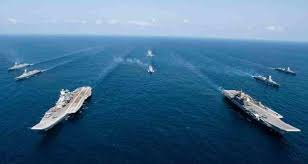Navy set to commission latest stealth frigate Tamal in Russia in July

India’s naval strength is set to receive a significant upgrade with the commissioning of INS Tamal, a modern stealth frigate. The Indian Navy will formally induct the warship on July 1, 2025, during a ceremony at Russia’s Yantar Shipyard in Kaliningrad. This event marks the end of India’s reliance on foreign-built warships, as Tamal will be the last major Indian warship constructed abroad.
A New Chapter in Indian Naval History
India signed the deal for INS Tamal in 2016 as part of a two-frigate agreement with Russia. The ship belongs to the updated Talwar-class, which evolved from Russia’s Krivak-III design. Its sister ship, INS Tushil, is undergoing sea trials and will follow a similar path.
With Tamal, India begins a new chapter. Future warships will be built domestically, supporting the country’s Atmanirbhar Bharat (self-reliant India) initiative. This shift highlights India’s growing naval design and manufacturing capabilities.
Advanced Stealth and Combat Features
INS Tamal brings multi-role capability to India’s fleet. The 3,900-tonne frigate is designed for air, surface, and submarine warfare. Its stealth features help reduce radar visibility, giving it an advantage in contested waters.
The ship carries a powerful weapons package:
- BrahMos supersonic cruise missiles for long-range strikes
- Shtil-1 surface-to-air missile system for air defense
- A 100 mm main gun and close-in weapon systems (CIWS) for close combat
- Torpedo tubes and anti-submarine rocket launchers for underwater threats
- A multi-role helicopter deck for extended reach and surveillance
Tamal can reach speeds of over 30 knots (around 55 km/h) and can cover up to 3,000 kilometers in a single mission. It is well-suited for long-range patrols, anti-piracy operations, and power projection in the Indian Ocean Region.
Assigned to the Western Fleet
After the commissioning in July, the ship will sail to India and join the Western Naval Command by September 2025. Based in Mumbai, this fleet monitors the Arabian Sea, a crucial route for global oil trade and strategic shipping.
With Tamal in its ranks, the Western Fleet gains a capable asset for surveillance, patrols, and combat readiness. It will also participate in joint naval exercises and help India respond to regional threats more effectively.
Building Tamal Amid Global Challenges
The construction of INS Tamal faced hurdles due to the Russia-Ukraine conflict, especially in sourcing critical components. Ukrainian engines were delayed, and global sanctions affected logistics. However, Indian and Russian teams collaborated closely and kept the project on schedule.
Over 200 Indian Navy crew members trained in Russia to prepare for the ship’s operation. This effort ensured a smooth transition once the ship enters Indian waters.
The ship also includes around 26% indigenous components, such as communication systems and navigation aids. This blend of Russian design and Indian technology shows the Navy’s commitment to self-reliance.
A Lasting India-Russia Defense Link
India and Russia have enjoyed a strong defense relationship for decades. Projects like the INS Vikramaditya, MiG-29K fighter jets, and S-400 missile systems show their long-term collaboration. INS Tamal continues that legacy.
However, India is now focusing on building its own fleet. The future belongs to Indian shipyards, such as Mazagon Dock and Goa Shipyard, where new warships and submarines are already under construction.
India’s Indigenous Naval Future
The Indian Navy aims to operate 175 warships by 2035. Most of these will be built in India, using Indian steel, electronics, and defense systems. Projects like P-17A stealth frigates, P-15B destroyers, and indigenous aircraft carriers are already in advanced stages.
With every new warship launched in India, the Navy grows stronger and more independent. Tamal represents the last foreign-built warship and the beginning of a fully self-reliant Indian fleet.
Conclusion
INS Tamal is more than just a new addition to the Navy. It represents strength, collaboration, and progress. Built in Russia and operated by Indian hands, the ship carries with it the legacy of global cooperation and the promise of a powerful, indigenous naval force.
As it sails into Indian waters later this year, Tamal will not only guard our coasts but also symbolize India’s ambitions at sea—silent, swift, and ready.






